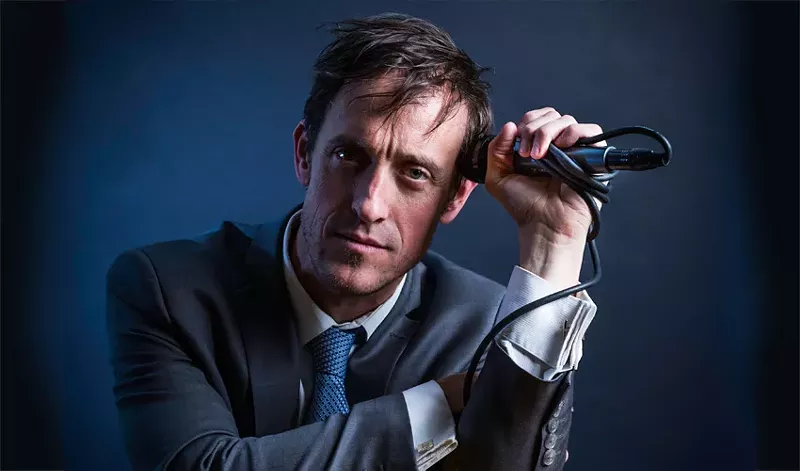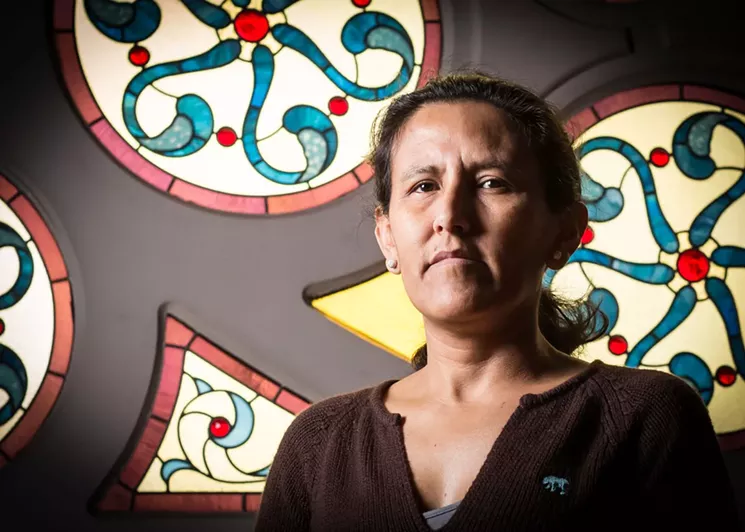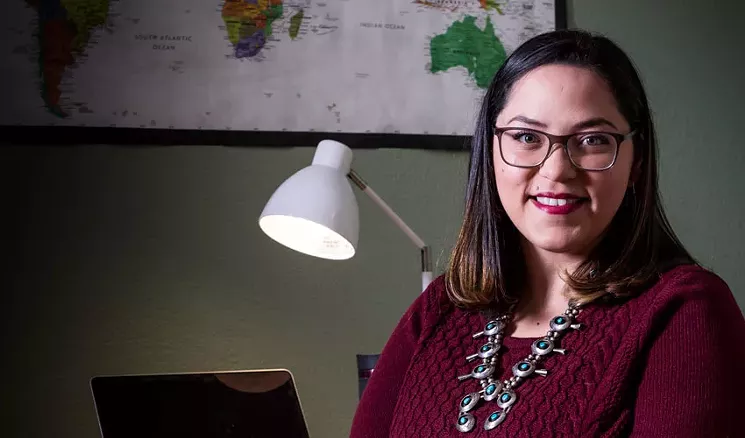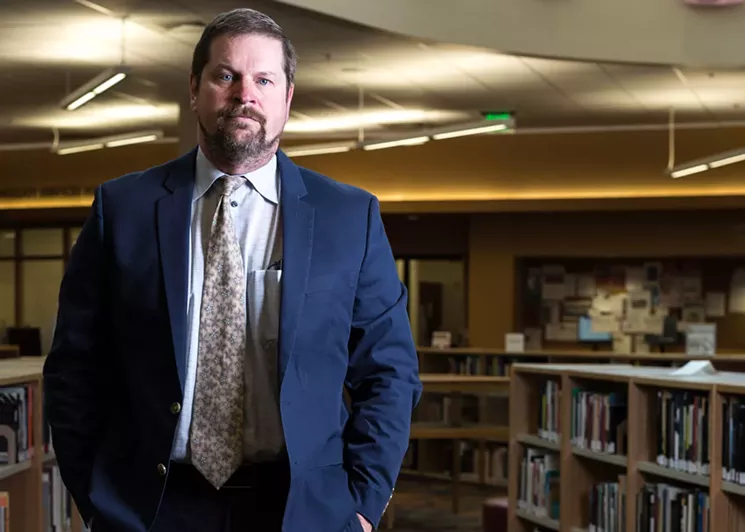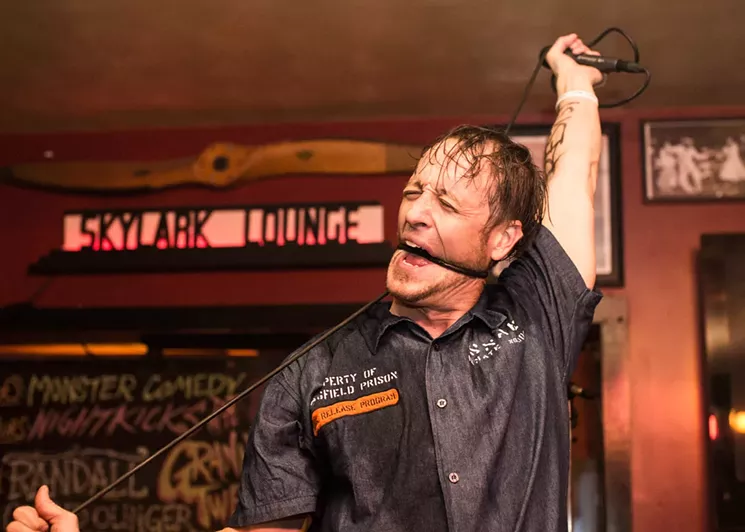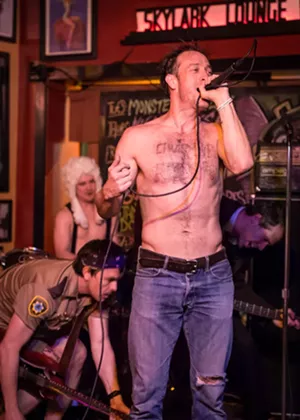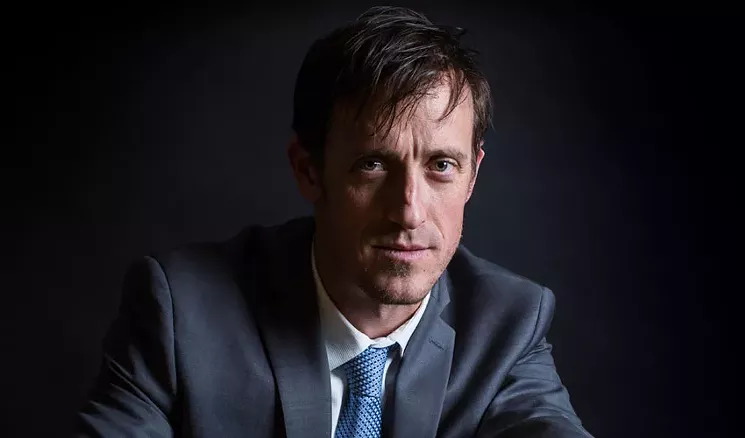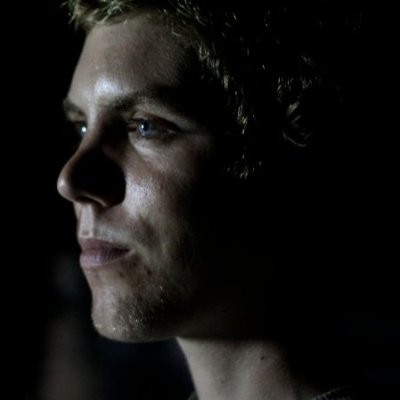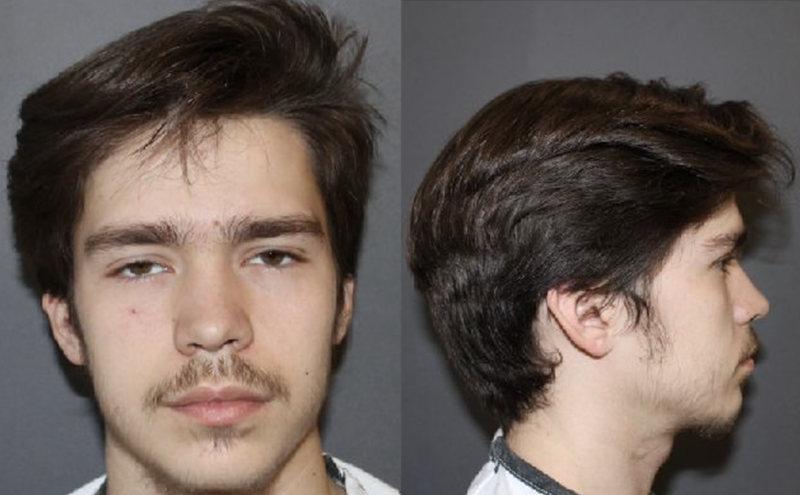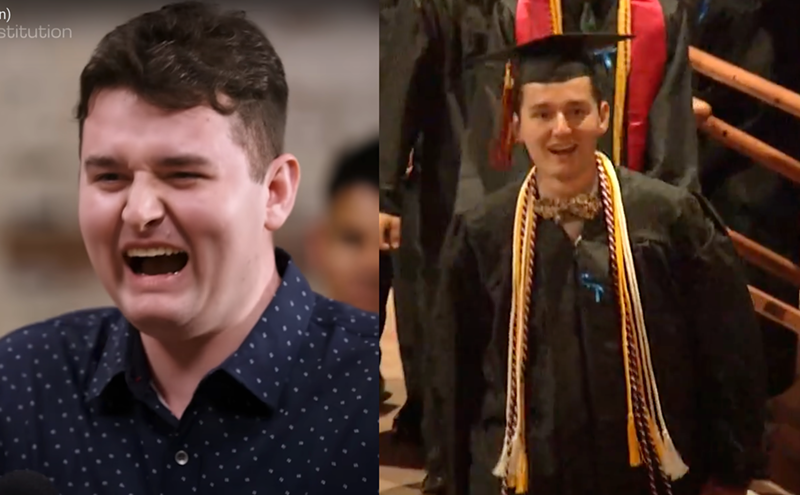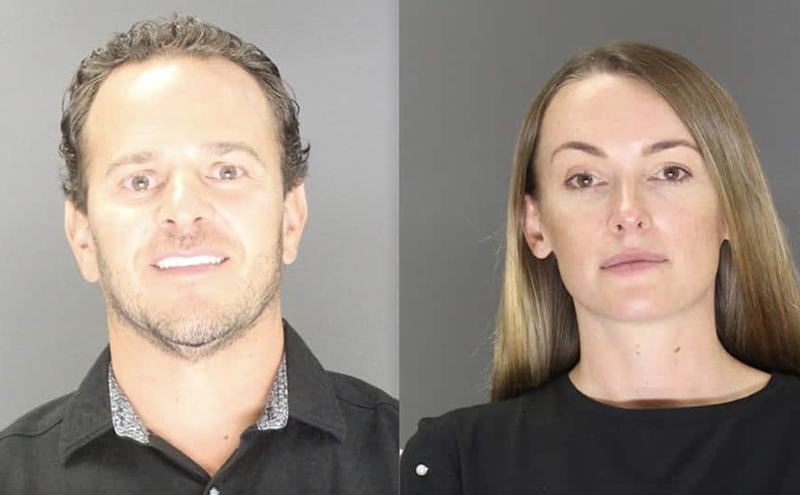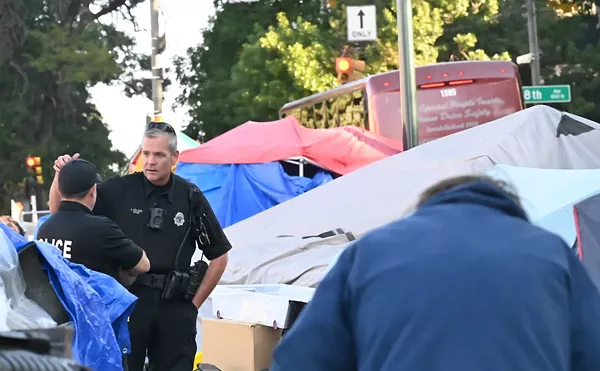A Denver defense attorney and friend of Meyer’s who was at the Lindsey-Flanigan Courthouse had spotted what she believed to be multiple Immigration and Customs Enforcement agents stalking its hallways.
“We’ll be down there in five minutes!” Meyer shot back.
The tip was exactly what Meyer had been waiting for. Having had multiple clients arrested by ICE agents inside local courthouses over the years, he’d been appalled to hear lawyers with the Denver City Attorney’s Office state at two community forums that month that the city had no knowledge of ICE using Denver’s courthouses to apprehend people.
Meyer not only knew it was happening, but he understood that ICE’s infiltration of the courts could have a chilling effect on the judicial system: Afraid of being picked up, non-citizens might not show up for their own trials or to testify as witnesses in other cases.
“Go! And ask as many questions as you can,” Meyer instructed Whitney Leeds, an associate at his firm.
Leeds grabbed law clerk Tyler Stokes and raced the six blocks from the law office on Santa Fe Drive to the courthouse. Once inside, she saw three men who looked like undercover cops, all wearing ball caps, one by an elevator, two standing awkwardly in a hallway with their hands stuffed into their sweatshirt pockets. At Leeds’s direction, Stokes pulled out a cell phone and began shooting a video, following right behind Leeds as she confronted the men.
“Hi. Are you here with ICE?” Leeds asked the two men in sweatshirts.
One jerked his head back in surprise. “And you are...?”
“I’m Whitney. Nice to meet you.”
She extended her hand. The man kept his hands in his sweatshirt pocket. “Are you here with immigration enforcement?” she asked.
“Yes.”
“Are you here to make an arrest?”
“Yes.”
“Do you have a warrant?”
One of the men grimaced.
This is great! We finally got these assholes! Meyer remembers thinking when he saw the video. The attorney was excited that he’d obtained irrefutable evidence of a practice that Denver officials weren’t acknowledging, and he was also incensed that the ICE agents appeared ready to make an arrest without a warrant, much less without having informed the court’s staff of their presence.
Still, Meyer and his team spent a week figuring out how to release the video in a way that wouldn’t cause widespread panic in immigrant communities. They eventually elected to release it in tandem with a twenty-minute “Know Your Rights” video in Spanish, laying out the facts while stressing the importance of reporting for court dates.
Since the video was released on February 23, the issue of ICE agents inside courthouses has gained national attention, in large part because the chief justice of the California Supreme Court sent a strongly worded letter to Attorney General Jeff Sessions and Secretary of Homeland Security John Kelly asking them to stop “stalking undocumented immigrants” and making arrests at courthouses. On March 31, Sessions and Kelly responded to the letter, saying that the Trump administration does not plan to change the practice and claiming that it’s safer for ICE to operate in courthouses because everyone has to enter through secure screening.“I was a huge nerd and very introverted. I was really into Dungeons & Dragons...and radioactive toward girls."
tweet this
While Meyer would like to see the feds change their practices, one of his goals for the video hits closer to home. “I want it to be used as an exhibit of what’s wrong and to drive policy change here in Denver,” he says.
Since President Donald Trump took office, Meyer has been at the forefront of multiple Colorado campaigns regarding immigration. He not only documented the presence of ICE agents at the Denver courthouse, but is the lawyer representing Jeanette Vizguerra, a mother of four who took sanctuary in a Denver church to avoid deportation; her story has been reported around the globe. He’s also on the legal team representing 60,000 current and former detainees suing the immigration detention center in Aurora over alleged forced-labor practices. And Meyer’s office has put unrelenting pressure on Denver officials to pass codified sanctuary laws that will protect all residents, regardless of citizenship status.
Outspoken and passionate, the 43-year-old attorney will take on the tough immigration cases that others won’t touch, colleagues say. But Meyer’s fights are as much against the system as they are for each of the 500 clients his office currently serves.
Raised in Aurora, Meyer didn’t grow up wanting to be a lawyer, much less one specializing in immigration law. After his father, a military man, split up with his mother, she was left to raise their son and daughter alone. Stuck making mortgage payments on a teacher’s salary, she sought out an additional source of income, and found one that Meyer credits with sparking his interest in other cultures and parts of the world.
“Starting from about age nine until I was fifteen, we hosted exchange students from all over the world: the Middle East, South and Central America, Eastern and Western Europe, Africa,” recalls Meyer. “It was an eye-opening experience for a kid coming out of north Aurora.”
A quiet and quirky kid, at that. “I was a huge nerd and very introverted. I was really into Dungeons & Dragons...and radioactive toward girls, so there was no problem there,” he recalls with a chuckle.
He looked up to the exchange students, most of whom were doing programs at local universities, and regarded them as siblings. They taught him about regions and religions and cultural practices he’d never imagined, like what Ramadan is and why some people pray five times a day facing a place called Mecca. “In hindsight — even though my mom was doing it to earn money — she also had a game plan in terms of showing us that there’s a bigger, larger world out there,” says Meyer.
By the time he graduated from high school, the idea of exploring that larger world had become a fixation. “I just wanted to get away from Colorado,” Meyer remembers. “I felt like if I was going to grow, then I needed to challenge myself with new experiences.”
That quest began when he enrolled at Pacific Lutheran College in Tacoma, Washington, and took on a new identity: He decided to change his first name from Chris to Hans, his middle name. The “new” Meyer dreamed of being a writer, and he soaked up all the Latin American history books he could find. For a short period after graduating from college, he fought fires for the U.S. Forest Service, traveling to flare-ups across rural Idaho, Oregon, Washington and Utah.“The public attention doesn’t make me feel like a star or unique; I see it as an opportunity to raise my voice and educate more people.”
tweet this
But Meyer still had his sights set on traveling, and as soon as he’d saved enough money through firefighting, he embarked on a globetrotting adventure. In January 1997, he took off from Denver on a flight bound for London. He wouldn’t return to the United States as a full-time resident for another three and a half years.
“I still had zero desire to be a lawyer at that time,” Meyer recalls. “I pretty much wanted to be a short-fiction writer, a rock star and a ladies’ man...in that descending order.”
Meyer’s first stop was the Middle East. He worked on a kibbutz in Israel and spent time in Palestine and Egypt, talking to people who’d experienced armed conflict. Meyer felt like he hadn’t been getting accurate information from news outlets in the United States, and he wanted to know more.
He soon branched out to other continents, occasionally returning stateside for short visits to see family and to replenish his funds for traveling; one holiday season, he worked nonstop at the post office on Quebec Street.
Meyer was determined to get to Latin America, though; his curiosity had been piqued by his college studies of the area. “I had a theoretical analysis of U.S. intervention in Latin America, but it had absolutely zero context, so I really didn’t have a clue what I was talking about,” he says. “I always knew I was going to end up there.”
Having read work by Rigoberta Menchu and Eduardo Galeano, Meyer was particularly drawn to Guatemala and Mexico because of their indigenous movements. And when he arrived in Guatemala, he knew that the country would be more than a temporary stopover. Having only recently seen the end of a decades-long civil war, Guatemala was very much in the process of rebuilding itself. “Once you hit the ground in a place that’s recalibrating from years of civil war, it’s difficult not to become engaged in, and connected to, the work of civil society to demand accountability for human-rights abuses and look for the path forward for justice,” says Meyer. “That’s how I got involved in doing volunteer work in Guatemala and Chiapas, [Mexico] — around human-rights documentation.”
After a crash course in Spanish, Meyer got busy with grassroots organizing: coordinating language schools and working with local leaders to reintegrate guerrillas from the war. “There was a sort of invisible transition from being a visitor in Guatemala to it being my home,” recalls Meyer. “I think it was the first chance I had to reset my understanding of the world and start it again from scratch. And learning how to speak from the level of a four- or five-year-old and then re-engage the world from that place was really humbling, and it gave me the chance to connect with the people I was hanging out with.”
Six months later, Meyer took what he’d learned in Guatemala and went to Chiapas, to aid the Zapatista movement. In 1998, the Mexican military was trying to destabilize the Zapatista indigenous base of support, engaging in what Meyer calls “low-intensity warfare”: poisoning drinking water in rural communities, falsely accusing local leaders of crimes like sexual assault, and in some cases even abducting people.
Meyer entered the region to do “accompaniment” work, in which foreigners team up with locals to reduce their risk of persecution by their government. He caught the attention of authorities after he agreed to help indigenous organizers in Chiapas invite international journalists to document human-rights abuses at the hands of the Mexican government. Meyer helped bring in a delegation of about twenty reporters from Spain, France, the United States, England, Canada and a few Latin American countries. “Our plan was to fly them into the jungle so that they could document what was going on,” says Meyer. “When the military and Mexican immigration caught wind of that, they staged a huge sting operation at the local airport, where basically every organ of Mexican law enforcement — federales, state, municipal, immigration and the Mexican version of the FBI — all came in, detained all of us, interrogated everybody, canceled all of the journalists’ visas and then told them to leave.”
Meyer’s visa was also canceled. He was given 48 hours to leave the country, and soldiers were posted outside his home to ensure that he complied.
“Once you have your eyes opened to the struggles of other people like that, it calls a question for you about what you’re going to do about that,” reflects Meyer. “Are you going to engage that experience more, or instead go on and live the rest of your life? For me, I wanted to take what I learned in Latin America and turn it into something, even though I had no idea what that looked like.”
After more travels and another stint in Guatemala, Meyer got to apply his newfound knowledge when he returned to the States in mid-2000.
While he was learning Spanish, Meyer had met Higinio Mendez in a Guatemalan shantytown called La Pedrera, a hillside settlement of people displaced by Guatemala’s civil war. Mendez was old enough to be Meyer’s dad, but the two became close while teaching each other their respective languages.
Mendez faced regular discrimination and threats from the Guatemalan military during the post-war years. “He was not a combatant in the civil war, but because he was indigenous and a more progressive voice, he was associated with the left,” recalls Meyer. His stories were shocking, and Meyer decided he’d try to get his friend a tourist visa so that he could do a speaking tour in the United States and share his experiences with American audiences. But even with Meyer’s sponsorship, it was a years-long process before Mendez was finally granted entry into the U.S. for a three-month visit. The rest of Mendez’s family was rejected and had to stay behind in Guatemala.
Meyer was already back in Colorado, working as a paralegal for an immigration attorney, when Mendez arrived. “And while Higinio was here, he articulated to me some fear of going back to Guatemala related to persecution and his membership as an indigenous man,” he remembers.
After discussing options, the two decided that Mendez would apply for asylum. “And so began a three-year journey,” recalls Meyer.
Mendez moved into Meyer’s tiny, $450-a-month apartment across from Wax Trax Records in Capitol Hill. “We became like father and son figures to each other,” says Meyer, who helped his friend get a job at REI doing tailoring work, including repairing tents. “He was like the rock star of REI. People were always yelling, ‘HIGINIO!’”
As the months went by, Meyer became increasingly invested in Mendez’s case. “Being friends with somebody, and living with somebody, and going through the daily emotional impact of trying to understand and then navigate the immigration system was really eye-opening,” says Meyer. “I was going through it alongside him.”
This included the agony, for Mendez, of being separated from his wife and three children, which only intensified as time wore on. He would send $9 of every $100 he made to his family through Western Union, but the cash couldn’t fill the void left by an absent father figure; his sons were acting out in Guatemala, and Mendez began to wonder if he’d made the right decision.
A year into the asylum process, Meyer decided to become a lawyer and enrolled in night school at the University of Denver Sturm College of Law while working construction jobs during the day to pay his tuition. “My decision to go to law school was because of Higinio’s case,” he says.
The case ended up dragging on for two more years before there was finally a ruling on the asylum application. By that point, Meyer had accepted that Mendez’s prospects didn’t look good, “but just because the chances are low doesn’t mean it doesn’t hurt just as bad,” he says.
It took less than two hours of court hearings for Mendez’s fate to be decided: He had to return to Guatemala.
“One of the things that struck me while sitting in the gallery was just how disempowering and casual the legal system can be to people,” recalls Meyer. “It struck me: ‘Wow, people will pass judgment on a person’s life between coffee breaks or to get done by 11:50 so they can make it to lunch with a friend.’ That was an ugly, nasty and accurate summary of what immigration law is oftentimes. And I’ve carried that lesson.”
He carried it through his law school graduation in 2006. “I was pissed about what the government did to my friend Higinio and wanted retribution, man,” Meyer remembers. “And retribution for me is looking for justice for other people where justice had failed Higinio.”
Meyer first sought retribution as a public defender, doing criminal cases, and then began advising nonprofits such as the Colorado Immigrant Rights Coalition. He’d noted some glaring flaws in the criminal-justice system when it came to informing non-citizens about the potential immigration implications of taking plea deals, even for minor cases like shoplifting or possession of marijuana. “I identified back then that immigrants were primarily being deported because of contacts with the criminal-justice system and not being advised correctly,” says Meyer. “And I realized that the contribution I could make was making sure that didn’t happen.”
In 2011, he decided to establish his own law firm, and opened the doors of the Meyer Law Office as a one-man shop.
“One of the templates I looked at was the marijuana legalization effort,” Meyer says. While doing work with cannabis attorney Brian Vicente, he explains, “I learned the power of using the media when the courts fail you, because that battle was about changing people’s perceptions. And if you could change people’s perceptions about drugs, then you might be able to change people’s perceptions about immigration, as well.”
Today, the Meyer Law Firm employs eleven people full-time. Meyer estimates that 75 percent of his cases involve clients who would rather stay out of the spotlight while they resolve their legal issues. But a few of his other clients have been willing to go public and use their cases to illuminate larger, systemic problems with this country’s immigration laws.
As an example, Meyer points to Claudia Valdez, whose case influenced Colorado’s practices around immigration “detainers” — when ICE asks local jails to hold on to suspected undocumented inmates past their sentences so that the agency has extra time to process and possibly detain them for deportation proceedings.
In July 2012, Valdez, a fifteen-year resident of Denver and undocumented immigrant from Mexico, was apprehended by ICE on a detainer. She’d asked a neighbor to report a domestic-violence dispute she was having with her husband and was then arrested by Arapahoe County police officers, who’d erroneously identified her as the perpetrator instead of the victim. Although the charges against Valdez were dropped, after she’d been booked into jail, ICE was able to grab her and transfer her to an immigration detention center to face deportation hearings.
By then, Meyer had represented many clients who’d been picked up on immigration detainers, and he’d been trying to figure out a way to shine a light on the issue. He realized that Valdez’s case might spark enough public outrage to permanently change the practice in Colorado. Since 2008, he’d also been holding on to a legal argument that justified non-cooperation with immigration detainers that he’d come across in the William Mitchell Law Review, written by attorney and professor Chris Lasch, who — conveniently for Meyer — had moved to Colorado in 2010 to teach at the University of Denver.
“Detainers weren’t an area of law that a lot of people had given thought to, except someone like Hans, who had seen the effects on his clients,” says Lasch, who today collaborates with Meyer. “He saw the value in the broader idea: what the legal limitations on federal power might be with respect to detainers.”
With assistance from Lasch and the ACLU of Colorado, Meyer used Valdez’s case to pressure Arapahoe County to stop honoring ICE detainers. Federal courts have since confirmed that city and county jails do not need to comply with requests from ICE to hold on to undocumented inmates past their sentences unless presented with a warrant. “Claudia’s case really helped tip the balance and made them understand that there were serious legal problems with what they were doing,” says Lasch. “Her case was instrumental in forming good policies.”
Today, no sheriff’s departments in Colorado will honor immigration detainers — a stance that has recently drawn the ire of the Trump administration. In fact, the Department of Homeland Security is now publishing weekly reports of jurisdictions that “decline” detainers — Denver, Jefferson, Boulder and Weld counties among them. Attorney General Sessions has warned that declining detainers is cause to withhold federal funding from cities and counties, as Trump threatened in a January 25 executive order.
Lasch believes that Meyer is fully armed for the fight ahead. “One of the reasons why I think he’s so good at what he does is because he has practical experience on both the criminal side and the immigration side,” he says. In legal circles, that combination is known as “crimmigration.”
“It’s like being bilingual. [Meyer] knows both of these fields to the level of being fluent in both of them, and that’s unusual,” Lasch adds. “It’s in times like these that we really need people like Hans.”
On a recent Wednesday night, around forty teenagers and adults gathered in the cafeteria of Adams City High School in Commerce City. One of only a few white people in the group, Meyer was easy to spot, his brown hair slightly disheveled and the arms of his plaid button-down rolled up past his elbows.
As a wall-mounted clock ticked past 7:30 p.m., Meyer got up before the audience at this “Know Your Rights” presentation and asked if everyone spoke Spanish. They all did, except for a Somali woman and one other woman Meyer promised to talk to separately.
An associate of Meyer’s drew everyone’s attention. “Buenas noches, guys, yo soy Julie Gonzales,” she said.
“In reality, she’s the brains here. I’m nothing but a lawyer,” Meyer joked in Spanish.
“What do you want to know about during this hour?” asked Gonzales.
People seemed hesitant to talk at first, but after a few volunteered questions, hands darted into the air and questions came in rapid fire.
“What do I do if ICE agents come to my house?”
“What plans should we have in place for our kids?”
“I have a student who’s been called to jury duty, and they’re undocumented. Should they go? Is it a trick?”
Meyer and Gonzales jotted down the questions as fast as they were asked. Gonzales has worked at the Meyer Law Office for five years, and recently took on the role of full-time policy director, a rare position at a law office.
Since Trump’s inauguration, her job has included facilitating these “Know Your Rights” sessions — twenty in March alone. The training, which includes advice on what immigrants should and shouldn’t say to ICE agents and how to identify a legitimate search warrant, are not just a way to ease fears in the community, but also a method of soliciting feedback and tips about increasing immigration enforcement.
“We’ve seen new levels of boldness from ICE agents conducting arrests,” says Gonzales now. “And Colorado hasn’t even seen the worst of it. We haven’t had a mass raid yet.
“There are some people who get paralyzed by fear, and there are others that jump into action immediately,” she continues. “The community is closing in and trying to think of potential places where they could be exposed. That’s been a huge place of feedback, hearing, ‘What about this situation? What do we need to do here?’”
Gonzales adds that it’s been illuminating to see what information sticks with the community and what doesn’t. For instance, despite repeatedly telling people that schools are safe spaces in Colorado — so far — Gonzales gave a presentation one night at a school when a cop car happened to be parked outside. “People didn’t come,” she says. “The fear is what stuck with them.”
And the tension can be contagious. At the Meyer Law Office, employees have had to develop coping mechanisms in order to remain effective while doing emotionally draining work. “I tease Hans because he does CrossFit and yoga, sometimes both in a day,” Gonzales says. “And I’ll say, ‘Oh, my God, you’re such a white guy.’ But he’s figured it out. That’s what he does in order to keep a clear head, and it works.”
The rest of the office often follows Meyer’s lead, taking an hour off most days to exercise. But Meyer has another way to blow off steam that’s all his own: It’s a loosely guarded secret that he’s the lead singer of a punk band called Wild Lives, which plays a mixture of original songs and covers by the likes of Fugazi, Black Flag, Minor Threat and the Distillers.
Meyer — who goes by the stage name “The Kid” — is quite the presence on stage, known to flop, flail, scream, cavort and writhe on the ground. “It’s always an interesting scene when we do a show,” says Blake Pendergrass, aka “Bonedogg,” the band’s drummer, who also plays in a Latin ska band called Roka Hueka. All five members of Wild Lives either work in the legal field or have done advocacy work for nonprofits.
Pendergrass teaches an ESL class at Adams City High School, and some of his students attended the “Know Your Rights” training there. He jokes that he’s had ESL students come to shows and are shocked to see Meyer — a man many are used to seeing wearing suits on television, talking about immigration — moonlighting as a sweaty punk rocker.
“This is fanfuckin’tastic. Like discovering Clark Kent’s true identity. Dr. Jekyll’s got a whole new bag. The calmest, sweetest man I know is a raging fucking demon. A man in full,” one lawyer posted on Wild Lives’ Facebook page.
On March 18, Wild Lives played a benefit concert supporting Casa de Paz, a refuge for immigrants and their families (“The House That Peace Built,” July 12, 2016), and all of the bandmembers dressed up as characters in a courtroom. Wild Lives’ next show is on April 22 at the Lion’s Lair.
“It’s so much fun, and it’s so terrible,” Meyer says of the band. But outlets like the band are necessary if he wants to stay energized for the fight ahead.
“I’d be lying if I said there weren’t times when I wanted to give up and say, ‘Fuck this, I can’t do this anymore,’” admits Meyer. “We lose a lot. And I feel like our law firm is one of the best in Colorado. I think there’s plenty of burnout, martyrdom and lost paths in this field, and I don’t want us to fall into it, which is a continual balance of figuring out how to take care of ourselves while making sure we can help other people. If you care about your clients and put yourself in their shoes, every loss is fucking heartbreaking. You remember the faces of kids whose parents’ cases you lost on your watch and on their dime.”
Those haunting memories date back to before Trump became president.
“For people who say Trump is inheriting a system that already existed under Obama, they’re right,” Meyer says. “Obama earned the moniker ‘Deporter in Chief’ because he did deport more people than any other president. It’s an unfortunate reality. But I like our fight now. It’s so, so clear today what the right thing to do is, [as opposed] to years that I had to fight Democrats about Obama’s immigration polices.”
Not only is the right thing to do clear, but Meyer’s learned how to do it. The trick is to identify a case like Claudia Valdez’s, that goes beyond an individual client, one that can push a larger cause and even force a policy change, and then push it strategically.
“There’s a piece of this in the court system, a piece in the community, a piece in the press and a piece in policy,” he says. “The sweet spot is when you hit all four in a way that each particular area feeds the change in the others.”
And Meyer believes he has a few cases that qualify right now.
The first is a class action lawsuit against the immigration detention center in Aurora, which is run by the private prison company Geo Group and can hold as many as 1,500 detainees at a time. In March, a U.S. district court judge granted class certification to 60,000 detainees who may have been subjected to forced-labor practices inside the compound, sometimes under threat of solitary confinement. An additional 2,000 plaintiffs participated in a voluntary work program that paid out $1 a day, a potential violation of minimum-wage laws.
Meyer has worked with a team of attorneys on the case, including Brandt Milstein of Boulder, providing some clients from his office to be representative plaintiffs in the class action suit.
Grisel Xahuentitla-Flores is one of them. During her five-month stay at the Aurora detention center, which ended in September 2015, she volunteered for the dollar-a-day program and was instructed to scrub toilets, showers and sinks for six hours each day. At first, Xahuentitla-Flores says, she did the work because she was bored. But as time went on, guards started ordering her to do more and more tasks, beyond what she’d volunteered for. It seemed like the Geo Group was making detainees essentially run the place in order to cut operational costs.
The stinginess of the private company extended to the detention center’s commissary, where she could spend her dollar-a-day earnings. Xahuentitla-Flores remembers that a bagged portion of Frosted Flakes cereal — maybe half a box — cost $6, a luxury she could only afford after 36 hours of scrubbing bathrooms. Most detainees used their money to make phone calls, which were $1 to connect, then ten to 15 cents a minute thereafter.
“‘You don’t have rights. You’ve got to do what we tell you,’” Xahuentitla-Flores remembers guards telling her. She calls the entire experience “degrading.”
Taking on the Geo Group, which brings in more than $1 billion a year from private prison contracts, was only possible because lawyers and immigrant advocates worked together, Meyer says. “All of the fish in the medium-sized pond of Denver couldn’t separately accomplish the change. But if we all worked together between the ACLU and immigrant-rights organizations and others, we could,” he adds. “It took individual fish in that pond to come together and create a bigger fish that could take on Geo.”
In a statement, Geo Group Vice President of Public Relations Pablo Paez says: “We have consistently, strongly refuted the allegations made in this lawsuit, and we intend to continue to vigorously defend our company against these claims. The volunteer work program at all immigration facilities as well as the minimum-wage rates and standards associated with the program are set by the federal government under mandated performance-based national detention standards.”
Another potentially policy-changing case is that of Jeanette Vizguerra, a Denver activist who is currently taking sanctuary from her ordered deportation with three of her children in the basement of the First Unitarian Society in Capitol Hill. Vizguerra entered the United States from Mexico more than twenty years ago and became known to immigration enforcement when she was pulled over by police in 2009 and didn’t have a driver’s license or vehicle insurance. From there, it was discovered that she was undocumented and had once used a made-up Social Security number on a job application. She’s been fighting to remain in the United States ever since.
This past February, as Vizguerra was waiting on an application for a special “U visa,” a stay of her removal expired. Rather than renew her stay, ICE agents were ready to arrest her; Vizguerra moved into the church in hopes that ICE will honor the tradition of religious sanctuary while she figures out what to do next.
News of her situation has gone viral; her story has been covered by CNN, the New York Times, and even large, international press outlets like France 24. Meyer says his office is also fielding inquiries from the podcast This American Life and even novelist Dave Eggers.
“Being here, in a certain way, is like being in prison,” says Vizguerra. “The positive difference is that I’m with people I’m close with, who are in the fight and who are helping me and protecting me.”
On some days, Vizguerra will do marathon media interviews, with barely enough time for a bathroom break between conversations. “The public attention doesn’t make me feel like a star or unique; I see it as an opportunity to raise my voice and educate more people,” she explains. “This isn’t my fight alone. What’s stressful is that this is for my community, and I feel responsibility at a national level to represent a face and a voice — not just for Mexican and Latino immigrants, but for all immigrants.”“I think it’s pretty clear that ICE has declared open war on the immigrant community since the first day of the Trump administration.”
tweet this
Back in 2013, Vizguerra was one of the driving forces in setting up the Metro Denver Sanctuary Coalition, which now consists of nine congregations; the group had previously provided sanctuary for other immigrants, including Arturo Hernandez Garcia (“Sacred Ground,” February 24, 2015). Before she claimed sanctuary herself, Vizguerra’s role in the movement was kept secret out of concern that it would negatively affect her immigration case. But now, since the Trump administration has signaled that all undocumented immigrants are eligible for deportation, that has changed.
Vizguerra’s case is important because it relates to detainers, DU’s Lasch notes; although Colorado counties no longer honor them, Vizguerra was originally apprehended by ICE on a detainer. “If Colorado had been where they are now when Jeanette’s case came along, she’d be a free woman,” he points out. “She would not be in sanctuary at the church while her four kids are trying to make do.”
Lasch and Meyer believe that Denver needs to strengthen its commitment to protecting non-citizens by passing its own sanctuary policies. “You only need religious sanctuary if you don’t have proper sanctuary from the city,” says Lasch.
But since Trump issued his executive order on January 25, Denver has declined to formally declare itself a “sanctuary city.” City attorneys and other representatives from Mayor Michael Hancock’s office have repeatedly noted that the sanctuary label has no legal definition; they believe that Denver is not in violation of any laws or the specific wording of Trump’s order threatening to remove federal funding from non-compliant cities.
On the day that order came out, Hancock said that Denver was not a sanctuary city. Three days later, he said this on a video released by his office: “If being a sanctuary city means that we value taking care of one another, and welcoming refugees and immigrants, then I welcome the title.”
While Hancock was equivocating about Denver’s sanctuary-city status, other mayors around the country were openly defying Trump, Gonzales notes. Boston mayor Marty Walsh said that when it comes to providing sanctuary, Boston would “use city hall as a last resort.”
“That’s leadership,” she says. “I kept watching that video that Mayor Hancock put out and was thinking, ‘What does this even mean?’ While I appreciate the idea that Denver wants to be a welcoming city, my question back is, what does that mean in terms of policy when you know that ICE is like the dog pulling at the leash, hoping to break free? Congress may not agree what day of the week it is, but the State of Colorado and City of Denver can make those [sanctuary] determinations.”
The video’s vague language did not calm immigrant communities. Nor did the city’s subsequent assurance that it will file a lawsuit should federal funding actually be denied, even though Denver has joined 34 other cities and counties by filing a “friend of the court” brief in the legal battle that Santa Clara, California, is leading against the executive order.
“I think it’s pretty clear that ICE has declared open war on the immigrant community since the first day of the Trump administration,” says Meyer. “It would be nice to see elected officials in Denver step up with a sanctuary policy of substance that even approximates the level of courage that Jeanette Vizguerra has showed the entire world in standing up to Donald Trump.
“Denver wouldn’t even be leading that pack,” Meyer continues. “We’d be in the middle of that pack. We wouldn’t be going out on a limb that other cities aren’t already out on.... It just requires some political courage.”
Over the past six weeks, Meyer and Gonzales have been working behind the scenes with community groups and individuals like Lasch to draft a comprehensive sanctuary policy that they hope the city will adopt. They plan to unveil the draft at a public event at 6 p.m. on April 27 at Saint Cajetan Catholic Church; it will spell out the ways that Denver officials will agree not to cooperate with federal immigration enforcement, including not honoring detainers, not telling ICE when inmates will be released, not collecting or turning over data about residents’ countries of origin, and creating a legal defense fund similar to what exists in New York state and Los Angeles.
Meyer says he’s playing a delicate game with the city: being vocally critical while also extending a hand to work together.
Asked for the city’s current position on a sanctuary policy, Hancock spokeswoman Jenna Espinoza sent the following:
“The safety and security of our residents is our number one priority. This includes protecting the rights and security of our immigrant and refugee community. When someone is in the ICE ‘system,’ the city has limited influence, as immigration issues fall under federal, not local jurisdiction.... Denver’s role is to continue our work with the legal community, law enforcement and community groups to protect our residents’ rights and safety.
Hans Meyer has been part of those conversations, and we greatly appreciate his contributions.
“There is no legal definition of what a sanctuary city is. Therefore, declaring Denver a sanctuary city does not provide our people with any more protections under federal law. We are working with our partners in the immigration and law enforcement community to develop substantive policy reform to ensure the rights of our immigrant and refugee community are protected.”
And in fact, on April 6, weeks after the Meyer Law Office published the video showing ICE agents in the courthouse, Denver officials — including Mayor Hancock and all Denver City Council members — sent a letter to ICE Acting Field Office Director Jeffrey Lynch asking that ICE agents stay out of Denver’s courthouses and other “sensitive locations” like schools. The letter references the video, and says that city prosecutors have had to drop multiple cases because witnesses were afraid to report to the courthouse.
As Meyer sees it, getting the city to acknowledge the practice and then send a letter to ICE is significant progress. “When the city initially said that they didn’t believe it was happening, that was dangerous, because that means that people who are making policy have no idea what’s actually happening,” says Meyer. “But this letter is a strong first step toward restoring trust in local communities. It is imperative to enact policy to extract ICE from Denver courtrooms, jails, probation offices and schools.”
Meyer is particularly interested in obtaining more evidence of how ICE is piggybacking on Colorado’s criminal-justice systems. “The next big issue is probation; that’s where ICE is fixing the game,” he says. “We have probably twenty to thirty clients who were picked up in probation offices. It’s our next target.”
No matter what course the city and state choose going forward, Meyer won’t stop advocating on behalf of his clients and the community. “If we can’t look our clients in the face and say we’re fighting for changes to protect them and keep them from having problems in the future, then we’re not doing the right thing,” says Meyer.
“That’s why we’re outspoken, because we don’t have the luxury of speaking abstractly. If we don’t win these reforms, our people lose and those children don’t have parents. End of story.”

